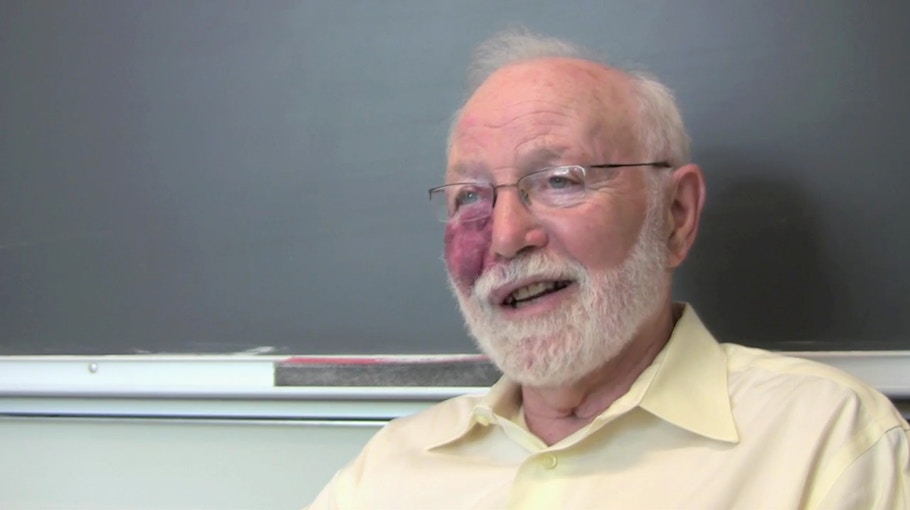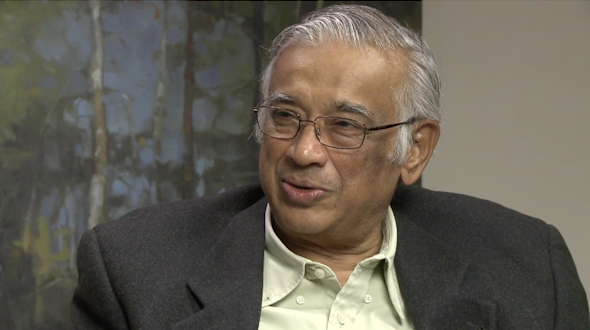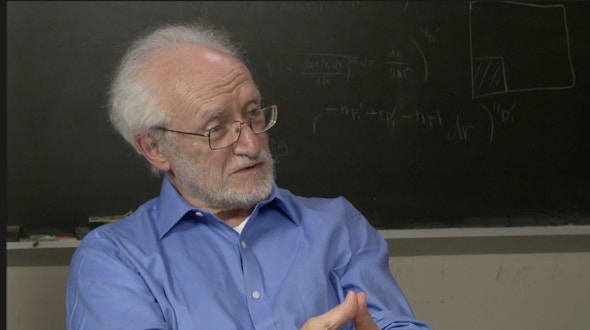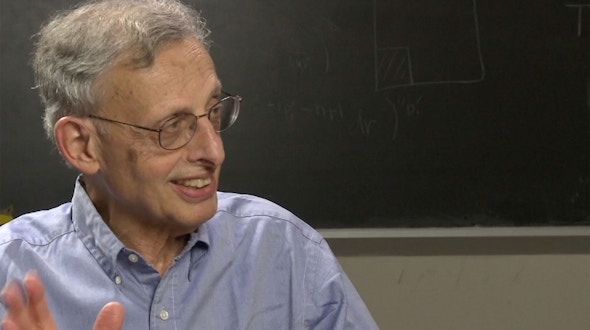Isadore Singer (1924 – 2021)
When he arrived as a graduate student at the University of Chicago after World War II, Isadore Singer thought that he would study mathematics for only a year or two. “I applied to the mathematics department because I needed to know more mathematics, both for relativity and quantum mechanics. After I had learned what I needed to know, then I would go back to physics,” Singer says. “But that never happened.”
As it turned out, it was a good thing for mathematics that Singer changed his plans. Surprisingly, it was a good thing for physics, too. Singer would become one of the most effective ambassadors between the two disciplines. The Atiyah-Singer index theorem became a mainstay for physicists, helping them understand the topological “anomalies” that arise in the transitions from classical physics to quantum physics to string theory. Singer’s weekly math-physics seminar, begun at Berkeley in the 1970s and transferred to the Massachusetts Institute of Technology in the 1980s, was the confluence at which the pure waters of math mingled with the dark waters of physics (or vice versa, for physicists). The seminar meetings would start in the afternoon at the university, continue over dinner at a Chinese restaurant, and usually not end until late in the evening. (Read about Singer’s collaborator Michael Atiyah).
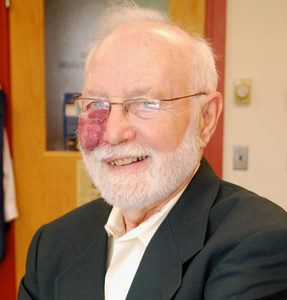
Singer has continued to defy the clock, and the calendar, by staying active long past the conventional retirement age. In his seventies, he voluntarily took on the task of teaching calculus to freshmen—not as a professor, but as a teacher’s assistant, a job usually performed by graduate students and instructors. “I wanted to understand MIT better, and thought that a good place to start was with freshmen,” he says. He still plays tennis twice a week—three times in summer—and at a very high level. “He really runs, at age 85!” marvels his colleague from Harvard, Michael Hopkins. His former student, Daniel Burns, notes, “Is has always had a very specific, jaunty walk. He bounces around on the balls of his feet. It’s part of his panache, like wearing cravats rather than ties. I have an idea that he likes movement like this, and it’s related to why he likes tennis.” Singer himself says simply, “I play tennis to learn. I think that’s true of everything I am interested in—I do it to learn. In mathematics and physics, when I’ve learned enough, I can explain it to others.”
This spring, three landmark events occurred in Singer’s life. First, he decided to retire at the end of the 2010 academic year. Second, he agreed for the first time to allow his friends to organize a birthday conference for him. And third, at the conference, he announced that he was closing the doors on his seemingly eternal math-physics seminar. The last talk at the seminar—though no one knew it at the time—was given by Orlando Alvarez, a physicist at the University of Miami. Alvarez had attended the seminar many times as a young faculty member at Berkeley, nearly 30 years ago. “I learned a lot of math sitting in that seminar, and from talking to Is,” says Alvarez.
For Singer, these changes are not an indication that he is slowing down. “I will be able to focus completely on a number of hard problems that have accumulated over the years,” he says. “I have no qualms about retiring. In fact, I’m excited about it.” Let other people grow old; Isadore Singer is growing ageless.
For most mathematicians, even a single eponymous theorem is the pinnacle of a career. Singer has several. In global differential geometry, there is the Ambrose-Singer theorem. In C*-algebras, there is an important conjecture called the Kadison-Singer problem, based on their paper on triangular operators. The Ray-Singer torsion (also called analytic torsion) has important applications in topology and physics. The McKean-Singer formula introduced heat equation methods into index theory. Nevertheless, it is the Atiyah-Singer index theorem that will go down in history as Singer’s most influential contribution to mathematics, and indirectly to physics. In fact, both Atiyah and Singer consider it to be a theory, a still-developing branch of math, rather than a theorem. Its story begins with a physicist, Paul Adrien Maurice Dirac, who in 1927 discovered an equation that describes the wave function of a spinning electron.
Erwin Schrödinger had already written down a differential equation satisfied by the electron, but this second-order equation was unsatisfactory to Dirac for various reasons. For instance, it does not explain the Pauli exclusion principle, according to which two electrons cannot occupy the same quantum state simultaneously.
To describe the spinning electron, Dirac needed a differential operator that was a square root of the Schrödinger operator. (In other words, it would contain only first-order derivatives, but when applied twice it would give the same equation that Schrödinger had discovered.) He found one with coefficients that were not numbers, but matrices that followed special multiplication rules. Dirac’s operator, and the equation that went along with it, described the electron’s quantum state as a new kind of object that had been hitherto unknown to physicists and nearly unknown to mathematics: a “spinor field.”
The Dirac equation turned out to be fundamental to physics. It explained the exclusion principle; it explained the periodic table; it also led to the first successful prediction of a subatomic particle—the positron. But until Singer, no one realized how fundamental the Dirac operator was to mathematics. In a certain sense, it had to be discovered all over again.
In 1962, when Singer was spending a sabbatical in Oxford, Michael Atiyah asked him a seemingly innocent question: “Why is the A-roof genus an integer for spin manifolds?”
Without going into too many details, a spin manifold is one on which spinor fields can be defined, and the A-roof genus is an integral of a particular function defined over the entire manifold. It is very unusual for an integral that depends on a continuously varying parameter to take only integer values (as opposed to arbitrary real values). Singer conjectured that the A-roof genus was an integer because it was counting something. Specifically, he figured out how to define Dirac operators on spin manifolds, and conjectured that the A-roof genus counted the number of independent solutions of the Dirac equation (or the index of the Dirac operator).
Atiyah and Singer in fact ended up proving much more. Their index theorem explains not only A-roof genera, but a veritable honor roll of other classical theorems. It applies to a broad category of operators known as elliptic differential operators, and it is not limited to the special case of spin manifolds. Nevertheless, a central idea in the proof is to show that elliptic differential operators behave like Dirac operators. The Dirac operators are the template that all of the others must follow.
At the time, physicists had no inkling of what Atiyah and Singer had proved. Throughout the 1960s and early 1970s, physicists and mathematicians seemed to inhabit two different worlds. Physicists were studying “gauge theory,” which would ultimately unify three of the four fundamental forces—the electromagnetic force and the weak and strong nuclear forces. Mathematicians were studying “fiber bundles,” which are curved spaces with a flat vector space attached at each point. But in 1975, Singer’s former student Jim Simons, together with his colleague in the physics department at Stony Brook University, Chen Ning Yang, realized that gauge fields (in physics) and connections on fiber bundles (in mathematics) are exactly the same thing. Yang and Tai Tsun Wu subsequently compiled a dictionary for translating between the two disciplines.
“Jim told me about the Wu-Yang dictionary,” Singer says. “Shortly after that, there was a paper by Belavin, Polyakov, Schwarz and Tyupkin that gave solutions, called instantons, to the equations of motion for gauge theory. I came to Oxford and lectured on these developments around the end of 1976. Atiyah, Nigel Hitchin and I decided we should alert the mathematics community to these geometric solutions. Our paper used index theory to compute their dimensions, and introduced the subject of self-dual connections to mathematicians.”
“The physicists weren’t sure they had all of the solutions,” says John Morgan, the director of the new Simons Center for Geometry and Physics at Stony Brook. “That’s what the Atiyah-Singer index theorem says, that they had found them all.” Strictly speaking, the BPST solutions were all of the localized solutions, the ones that appear for an instant and then disappear (hence the name ‘instantons’). More spread-out instantons do exist, and they are twisted in complicated ways that give rise to physical anomalies.
In 1977, Singer moved to Berkeley for seven years. He decided to teach a course in gauge theory, so that he could understand why the physicists cared so much about the geometry of fiber bundles. “I had a lot of help from faculty and grad students in the physics department,” Singer says. “I added a seminar to the course to talk about the technical parts, and that’s how the math-physics seminar began.”
According to Singer, there are two main reasons for ending the seminar now. First, he has noticed a decline in interest by mathematics graduate students and postdoctoral fellows. Second, with the Large Hadron Collider at CERN coming online in 2008, the fashion in physics has turned toward concrete experimental predictions, lessening the enthusiasm for highly speculative, theoretical work, at least for the time being. “Things like that happen; it’s part of a natural cycle,” says Alvarez. “We will grow in different directions, and then we will find something common again.”
Singer’s seminar does have a spiritual successor: the Simons Center, for which Singer is a co-chair of the board of trustees. “I am very enthusiastic about the Simons Center,” Singer says. “My seminar met only once a week; it wasn’t a full-time operation. The Simons Center will have top-notch mathematicians and physicists who will meet and have lunch together daily. We expect a strong interaction.”
Judging from Singer’s track record, the Simons Center should have a bright future ahead of it. Singer, together with Calvin Moore and Shiing-Shen Chern, was also responsible for founding the Mathematical Sciences Research Institute (MSRI) in Berkeley in 1982. At the time, the idea of a publicly funded research institute in mathematics was very novel, and even controversial. By now, MSRI has become such a success that it served as a model for Britain’s Isaac Newton Institute.
Singer, who is a jazz aficionado, once compared working with Michael Atiyah to the Cole Porter song, “Anything Goes.” But his collaborators say that the phrase really describes Singer’s own approach to math. “He always knew the right examples to look at. He has a very concrete and down-to-earth style,” says Hopkins. “It is a lot like jazz music, direct and improvisational—and in the moment, like good jazz.”
“You get that sense with him that anything goes. He doesn’t have a predisposed idea of how the problem should work out, and he is willing to use anything. That’s why he was willing to really engage these visionary ideas of the physicists.”
